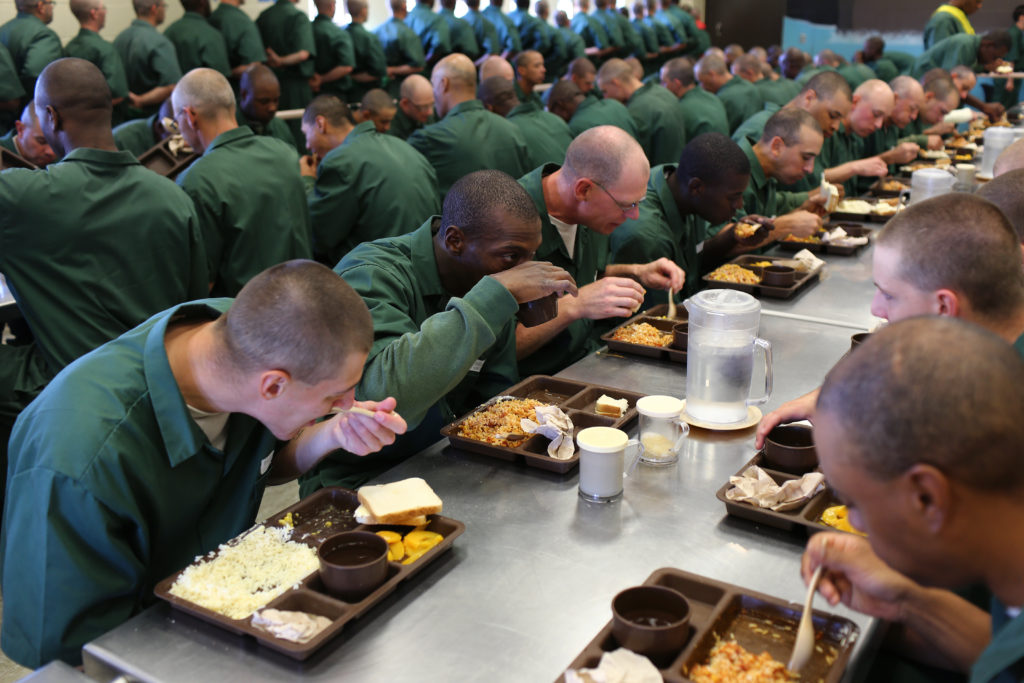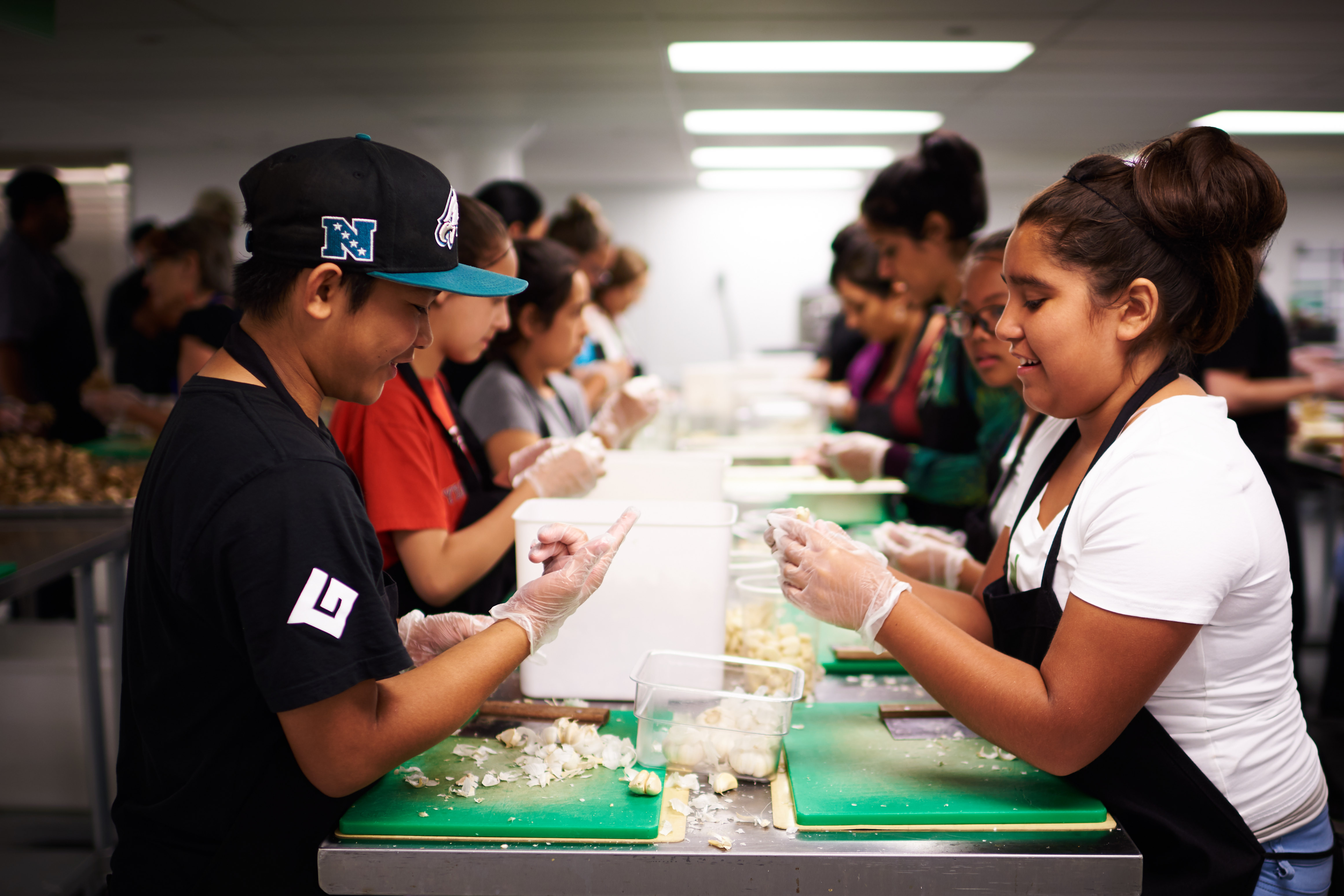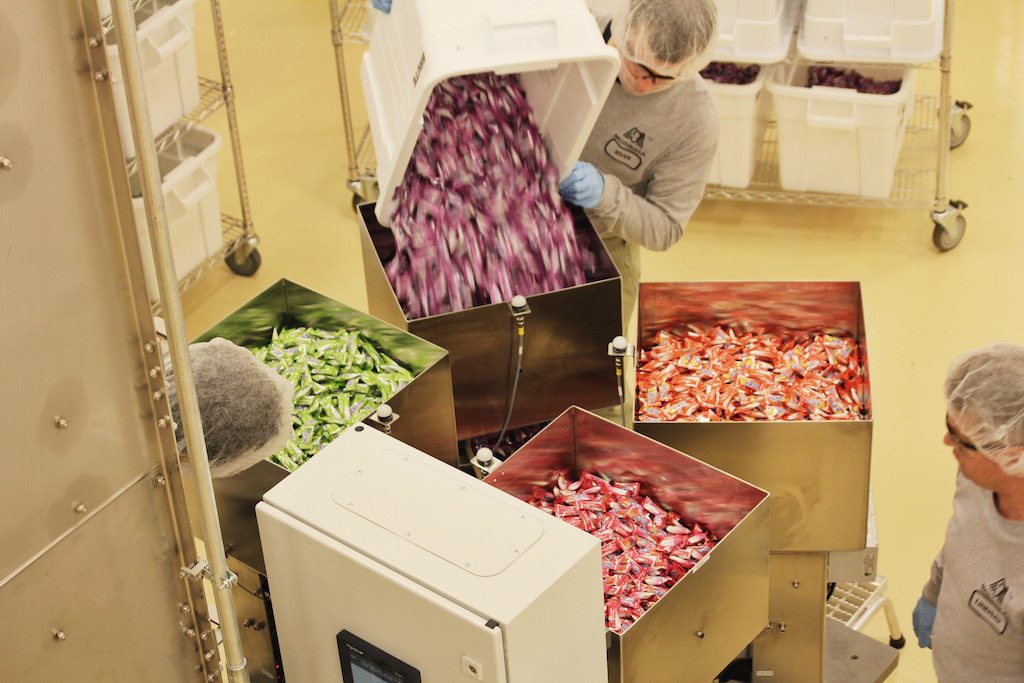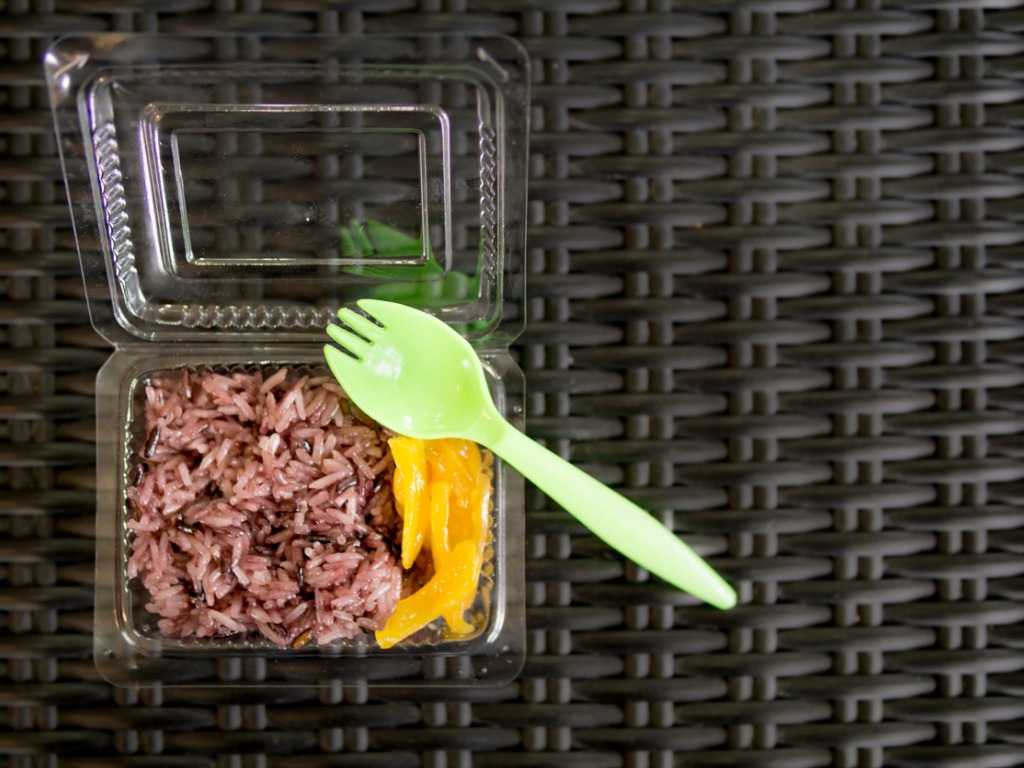
Getty Images / Andrew Lichtenstein
Lapses in food safety have made U.S. prisoners six times more likely to get a foodborne illness than the general population.
This won’t surprise anyone: The food served in correctional institutions is generally not very good. Even though most Americans have never tasted a meal dished up in a correctional kitchen, occasional secondhand glimpses tend to reinforce a common belief that “prison food” is scant, joyless, and unsavory—if not even worse. In August, the Detroit Free Press reported that a prison kitchen worker was fired for refusing to serve rotten potatoes. You can find nightmarish stories about maggots in national outlets like U.S.A. Today. Meanwhile, The Marshall Project’s more thorough, pictorial anatomy of daily correctional fare across the country found that most offerings barely fill a cafeteria tray—let alone a hungry belly. Reports like these reinforce the sense that criminal justice has a gastronomic dimension, that unrelentingly horrid food is a standard feature of the punishment prisoners receive behind bars.
This story was published in partnership with The Atlantic.
In 2018, it was a finalist for an Association of Food Journalists Award (food policy category).
But new evidence suggests that the situation is worse than previously thought, and not just because prison food isn’t winning any James Beard awards. It’s also making inmates sick.
According to a recent study from the Centers for Disease Control and Prevention (CDC), correctional inmates are 6.4 times more likely to suffer from a food-related illness than the general population. The report—which looked at confirmed outbreaks across the country between 1998 and 2014, and is the first update to the data in 20 years—underscores the fact that prison food is more than just a punch line, a flash point, or a gross-out gag on Orange Is the New Black. It’s a hidden public-health crisis.
The study, published in the American Journal of Public Health, found that inmates suffer from foodborne illness at a rate of 45 per 100,000 people annually, compared to only 7 per 100,000 in the general population. And 6 percent of all confirmed outbreak-related cases of foodborne illness in the United States took place in correctional institutions—significant, considering that less than 1 percent of the country’s population is incarcerated. At the same time, “desmoteric” outbreaks—the kind that occur in correctional institutions—were the country’s largest outbreaks in four of the 17 years studied. (In six other years, correctional outbreaks ranked within the top five.) Thirty-seven states reported at least one desmoteric outbreak during the same span.
What’s to blame for the dramatic rates of foodborne illness in jails and prisons? That’s harder to say. In some ways, the CDC study is highly specific about what’s making people sick: The agency determined that Clostridium perfringens and Salmonella were the most common disease-causing agents, for instance, and that tainted poultry products were the most common single culprit. But the data leave us with more questions than answers, since these raw numbers remain mostly uninterpreted. The study doesn’t cover the more systemic factors causing outbreaks in the first place.

The problems that arise in correctional food service tend to have mundane roots, even if the consequences can be dramatic
Mariel A. Marlow, one of the study’s coauthors, was reluctant to speculate about the underlying cultural, operational, and institutional conditions leading to high rates of illness. “Oversight and regulation of correctional institutions can vary by state and institution, so just to pull out certain factors is a little difficult,” she said. The correctional system is vast and highly variable: When it comes to food, a jail in Reno may be nothing like a federal prison outside New Orleans, and a private prison in Texas may look nothing like its counterpart one county over.
But an issue this widespread still signals the existence of underlying, systemic reasons inmates are six times more likely to be sickened by their food. As it turns out, the problems that arise in correctional food service tend to have mundane roots, even if the consequences can be dramatic. Institutions struggle to enforce basic food-safety standards: Though there are reports of corruption and negligence, the primary factor appears to be that many correctional facilities aren’t equipped to execute the food-handling protocols observed in restaurants and corporate cafeterias. And when mistakes are made, there are inconsistent processes in place to ensure improvement.
┓
Judging from news reports, you might think the main factor causing correctional outbreaks is the poor quality of the food itself. And certainly, a slew of well-publicized lawsuits have accused correctional facilities of buying and serving dodgy ingredients. In May, for instance, a class-action suit was filed against the Oregon Department of Corrections on behalf of current and former inmates, alleging that the state-run food service is so subpar it amounts to cruel and unusual punishment. In recent years, there have been news reports of inmates served rotten chicken tacos, rancid beef, and cake that had been nibbled on by rodents. Meanwhile, earlier this year, a Michigan judge dismissed a suit brought by an inmate who said he’d been repeatedly served moldy bread and spoiled hamburger meat. (According to U.S. District Judge Gordon Quist, the complaint was without merit: In his view, the Eighth Amendment does not entitle prisoners to “tasty or aesthetically pleasing” food, only to a diet that allows them to “maintain normal health.”)
The more cheaply prisoners can be fed, the more money can often be made by the people charged with their care.
Examples like these are unfortunately common, said Sara Totonchi of the Southern Center for Human Rights, a nonprofit that advocates on behalf of prisoners. Her organization commonly receives letters from inmates complaining about food quality, she explained by email, including being served rotten food.
But food-service providers don’t necessarily skimp on ingredients out of a malicious intention to punish prisoners. Instead, there are often systems of perverse incentives in play: The more cheaply prisoners can be fed, the more money can often be made by the people charged with their care.
Many state correctional systems outsource their kitchen operations to private food-service companies, which are usually paid a flat rate per meal to provide a full range of services—from raw ingredients to kitchen equipment and staff. (Two of the biggest players are Trinity and Aramark, which, together, serve hundreds of millions of correctional meals per year.) This arrangement can greatly simplify things for correctional operators without the bandwidth to handle meal service—but it can result in a raw deal for inmates, since companies paid by the meal can keep more money when they skimp on food.
To get a sense of why these arrangements can be problematic, look to an ongoing fracas in Michigan. After the Detroit Free Press reported in 2015 on a range of issues, from maggot-ridden potatoes to employee drug smuggling, the state prematurely terminated its $145 million contract with Aramark. The arrangement had been a “nightmare,” according to Senate Minority Leader Jim Ananich, a “completely irresponsible use of taxpayer dollars … [that] jeopardized the health and safety of inmates and prison employees alike.”
For its part, Aramark denies any wrongdoing. In an emailed statement, Karen Cutler, Aramark’s vice president of communications, wrote that Aramark hires registered dietitians to design meals that provide 2,500 to 3,000 calories a day, and suggested the company had been the target of a negative PR campaign by “opponents of outsourcing and special-interest groups.”

Inside a correctional facility’s walls, even basic food-safety standards can fall by the wayside
After Michigan hired Aramark’s main competitor, Trinity, as a replacement in 2015, the problems seem to have continued. Early this year, the state imposed a $2 million fine on Trinity, including $905,750 for “unauthorized meal substitutions,” $357,000 for delays serving meals, and $294,500 for sanitation violations. According to the Free Press, the poor quality and quantity of food served by Trinity was one factor that led to a riot that caused $900,000 in damage at a prison in Kinross, Michigan. Trinity did not respond to a request for comment.
In this case, the solution is simple: Eliminate arrangements that motivate people to underspend on food, and meals are likely to improve. But though stories about rotten potatoes can excite one’s darker curiosities, the conclusions of the CDC report point to a far more mundane culprit: Inside a correctional facility’s walls, even basic food-safety standards can fall by the wayside.
┓
During the 23 years he oversaw food operations at the Graham Correctional Facility in Hillsboro, Illinois, Joseph Montgomery says he never saw a major outbreak of foodborne illness from food served out of the prison kitchen. When inmates did get sick, he says, they were kitchen workers who’d smuggled inventory back to their cells.
“We have a population who will steal food from the general kitchen in various ways you probably wouldn’t want to try printing,” he says. “They will steal that product from the kitchen and take it back to their cell house. Their only way to have a refrigerator is if they put it in a container with a little bit of ice, but nine times out of 10 they don’t have ice. In the summertime, it’s going to sit on a windowsill or in a drawer so nobody sees it for two, four, six, eight hours.”
The most dangerous culprit is one you’ve probably heard about: pruno
The temptation for correctional kitchen staff to take food back to their cells can be profound, especially in situations where they’re being routinely underfed. But since harmful bacteria multiply rapidly at room temperature, the resultant standing time can be enough make people sick. Montgomery says he’s seen anywhere from two to 15 people sickened in a single incident from contraband food. And, according to the CDC report, this really does pose a significant safety issue. Of the 200 outbreaks reported since 1998, the food in question was only identified 41 percent of the time. But of those 82 outbreaks, 16 incidents—almost 20 percent—involved “illicitly obtained or prepared food.”
The most dangerous culprit is one you’ve probably heard about: pruno. A prison wine that can be made by fermenting stolen cafeteria supplies—cut fruit, sugar cubes, and ketchup—pruno is the rare correctional food-safety hazard that’s cracked the popular consciousness. Tongue-in-cheek pruno recipes have been featured in Food & Wine and the Los Angeles Times, a faux ad for “Pruno Creek Gourmet Prison Wine” ran on Conan O’Brien’s show, and fans suggest it’s what Poussey was swilling on Orange Is the New Black. According to the CDC, pruno was implicated in four out of 16—25 percent—of outbreaks known to result from contraband food (that’s about 2 percent of the total outbreaks studied).
It’s easy to see why pruno poisonings have made headlines in the likes of CNN, NPR, and The Atlantic, in recent years. It’s dangerous stuff, made under abysmal food-safety conditions—illicit, ad-hoc distilleries run in secret without proper supplies or oversight, by inmates willing to take risks for a brief reprieve from the monotony of prison life—conditions that can breed botulism, a virulent bacteria capable of causing paralysis and death. Montgomery says he’s known inmates to drink a version so strong that it ate through the sole of the rubber boot it was brewed in.
But while it’s true that underground food preparation tends to be lacking from a food-safety perspective, and makes for more sensational news reports, the food preparation happening under direct supervision can be just as inadequate—and appears to be a much more significant problem.
┓
Correctional facilities aren’t just giant housing complexes: They tend to be understaffed, oversubscribed cafeterias, ones that can be responsible for feeding thousands of people three meals a day. Food service on that scale can be a challenge even for experienced teams of culinary professionals, but sources say correctional kitchens are often forced to get by with undertrained staff, shoddy equipment, and poor oversight.
“I can tell you one thing: Nobody has food-safety training.”
Many state prisons choose to save money by using inmate labor in the kitchen, an arrangement with potential benefits. According to John Cornyn, a food-service consultant who’s spent a portion of his 40-year career working on correctional projects in institutions from California to New York, inmates tend to like the role. “One, you’re filling up your day with work, and two, the likelihood is that you’re going to eat well,” he says. The trouble is that most inmates don’t actually have experience working in kitchens, and some lack even the most basic commercial food-handling and safety-training skills.
Ernest Rich says he served 19 years of a 24-year drug-related sentence in the California state correctional system, and most of the time he worked in food.
“I can tell you one thing … Nobody has food-safety training,” he says. “You’ve got people coming in there all the time who know nothing about cooking. They’re learning as they go. They don’t know nothing about what you should do, what you should not do.”
In Rich’s experience, that lack of training means mistakes are common. “They don’t label things. They don’t rotate the stock the way it’s supposed to be. Those kitchens aren’t ran like ordinary kitchens should be ran,” he says.
That, according to Rich, means people get sick “a lot.”
“You may hear about people, 15 or 20 people get sick on one yard,” he says. “That’s stuff that you hear about all the time.”
According to the CDC report, outbreaks are most commonly caused by the kinds of unwitting, everyday infractions Rich describes. “Contributing factors”—additional conditions that enabled or amplified a food-safety hazard—were identified inonly 38 percent of cases. But in those cases, the ones we know about, two of the most common food-safety-hazard-related outbreaks were easily preventable: 26 percent involved food handled by an infected person, while 24 percent involved “inadequate cleaning of processing or preparation equipment or utensils.”

Food safety is not always top of mind for overburdened supervisors
Mistakes are made even more frequently in the absence of proper oversight, a scenario that seems to be all too common. In Illinois, Montgomery remembers there being 40 inmates on duty during the day shift, with three supervisors, at least one of whom, by law, was required to have professional food-safety training. That’s a ratio of about 13 inmates for every supervisor inside a 1,500-square-foot kitchen—about as good as it gets, he says. But both Montgomery and Cornyn said the ratio is more commonly 15, even 20 inmates per supervisor. That’s not ideal, especially because food safety is not always top of mind for overburdened supervisors.
“Security is your number-one priority, even in the kitchen. Food comes in second,” Montgomery says. “That’s what makes a food supervisor in corrections a really hard job. They have to be security-minded 100 percent of the time and put out a safe, quality product.”
The most dangerous culprit may also be the most mundane. According to the CDC report, 37 percent of outbreaks with a known contributing factor began simply because food was left out at room temperature for longer than is safe—the most common cause identified.
“I’ve seen [inmates] leave food out too long,” Montgomery said. “Kitchens are warm and they leave food on the counter as they’re prepping it.”
To an extent, this issue could be addressed through better training. But more systemic factors contribute, too. Most jails and prisons simply weren’t built to accommodate efficient food service, and Cornyn says that even in newly constructed facilities, the kitchens are designed almost as an afterthought—“the cheapest way possible.” That can be a huge mistake, he says, because prison kitchens typically need to be even larger than their commercial counterparts. In situations where “sharps”—knives attached to wire cables—are in use, inmate workers must be placed many feet apart. And many facilities don’t take advantage of space- and labor-saving machinery that speed up prep times in civilian restaurants—the whole point is to provide opportunities for manual labor. All these make larger kitchens necessary, and in cramped confines the work takes much longer than it should—setting the stage for potential food-safety hazards.
But the trouble continues once the food leaves the kitchen for the mess hall. For security and logistical reasons, many facilities can’t feed their entire populations all at once—they feed prisoners in waves instead, so that the dining hall is never overfull. This takes time, and often means food is left out, shift after shift.
“We don’t have the luxury in corrections to make partial batches a lot of the time. Most of the time you have to make the entire thing all at once,” Montgomery says. According to the U.S. Department of Agriculture, meat can sit out for only two hours above 40 degrees Fahrenheit before safety becomes an issue.
Simple improvements could do so much to keep inmates from getting sick. But no one is watching to make sure the situation improves.
Rabbi Aryeh Blaut routinely witnessed warm food left out at a federal prison in Massachusetts, where he spent time as an inmate 14 years ago. (Today, Blaut is the executive director of Jewish Prisoner Services, a nonprofit advocating for incarcerated individuals with kosher diet needs.)
“There might be two or three food shifts, but they’re not necessarily bringing in fresh food for each shift,” he said. “Through that time, the hot food isn’t being kept hot, and the cold food isn’t being kept cold.”
In overpopulated prisons, meal service can take so long that facilities are sending out food throughout the day. “I’ve been in situations where the meal finally is served, they clean up, and they start setting up for the next meal. It takes that long to get the food out,” Cornyn says. “That’s not ideal.”
The dire combination of untrained workers and space limitations make the already-daunting task of correctional food service all the more challenging. And though simple improvements could do so much to keep inmates from getting sick, the reality is that—unlike at public eateries—no one is watching to make sure the situation improves.
┓
A strict, uncompromising inspection system seems like an obvious solution to the prison system’s outbreak woes. Regular inspections work well, for the most part, in restaurants and school cafeterias, after all. Why shouldn’t that translate into the correctional setting?
Turns out, pretty much everything is different in a prison kitchen.
To start, state, local, and federal prisons across the country don’t follow the same rulebook. Federal prisons follow the Bureau of Prisons’ Food Service Manual (FSM), which is similar to the FDA’s Food Code (FFC)—the rule book used in restaurants. But the CDC points out a couple of key differences in its report. For instance, the manual lacks the FFC’s clear language about when a kitchen worker can start working after being sick. It also doesn’t explicitly say that federal food-service employees have to receive food-safety training.
Meanwhile, state and local facilities (which house about 10 times the number of inmates as federal facilities) can create their own guidelines. Sometimes that means adhering to the FDA’s Food Code, and sometimes that means using the Bureau of Prisons’ manual. But there’s no universal rule for food safety in state and local facilities. In Michigan, the problems under Aramark’s tenure prompted the state’s congress to introduce bills that would classify prison cafeterias as “food establishments,” meaning they’d have to act like restaurants and follow the FDA Food Code, requiring a food-safety manager to be present at all times. But those bills never passed the legislature. “Each state is different,” Montgomery explains.
Even when an inspector does find fault in the kitchen, penalties can be mild or nonexistent.
The inspection process is just as uneven. No uniform, nationwide rules govern how and when federal, state, and local prison kitchens are inspected. The process varies based on state and local jurisdiction—Montgomery explains that state facilities get inspected by state inspectors, but county jails get inspected by the county health inspector. These inconsistencies can make it easy for violations to slip through the cracks. In federal facilities, meanwhile, enforcement is left to the discretion of the institution’s Food Safety Administrator, who is given broad latitude. Weekly inspections are required but, according to the FSM, “procedures and reports for formal inspections … are developed locally.”
Even when an inspector does find fault in the kitchen, penalties can be mild or nonexistent. Think of it this way: A state-run agency isn’t likely to slap a hefty fine on another state-run agency, nor can inmates choose to take their business to an A-graded cafeteria over a B-graded mess hall. Even when private contractors are in charge (and can therefore be fined), penalizing slipshod safety practices is tricky—no matter what happens during an inspection, inmates have to be fed two or three times every day. Inspectors don’t usually have the last-ditch option of shutting down a prison cafeteria altogether.
Contracting with a third-party food-service provider can add another layer of complexity, as it’s not always clear who’s responsible for making sure the rules get followed. In Ohio, for example, Aramark and the Ohio Department of Rehabilitation and Correction disagreed over “shared responsibility” for kitchen cleanliness. In a study that interviewed correctional officers about Aramark’s tenure in Michigan, those same shared responsibilities were said to have caused tensions between correctional-facility officers and Aramark employees, who argued about whose job it was to purchase cleaning supplies. Problems can result from this unclear chain of command; according to the study’s author, “there was universal agreement across the focus groups that the kitchen areas became less sanitary with privatization.” As one officer quoted in the study put it: “Cleanliness is horrible. I don’t know how it passes any kind of inspection.” The trouble is that it can be unclear whose job it is to clean up the mess.
┓
While systemic disadvantages continue to compromise safety, existing regulations have failed to address common problems. Ultimately, then, the solution may fall to inmates themselves. Which is probably why, if the CDC report has one overarching recommendation, it’s that correctional facilities work harder to educate inmates on food safety. Even though high kitchen-staff turnover and low food-service budgets hinder progress, intensive food-safety training is one factor institutions can control.
It’s a rare win-win: Programs that work to provide inmates with food-safety certification can help reduce incidences of foodborne illness and provide formerly incarcerated individuals with a career path once they return to civilian life.

L.A. Kitchen provides foodservice training to residents of diverse backgrounds. There’s been a small movement to bring these kinds of workforce training programs inside prison walls
Photo courtesy of L.A. Kitchen
Ernest Rich says when he was incarcerated, he started working for Cal Fire (part of the state’s Department of Forestry and Fire Protection) in a program where inmates set up outdoor mobile kitchens to serve firefighters as they battle blazes. Maybe it was because the meals weren’t served inside a prison’s walls, but Rich noticed that food safety was taken much more seriously.
“They have a health inspector come by there and make sure that the food is being served and make sure everybody’s wearing gloves. They’re going to make sure that all this is going on. They don’t do that inside a prison,” he says.
At Cal Fire, Rich picked up the knowledge that would ultimately land him a job in food service when he returned to civilian life. He says he got involved with a reentry organization called HealthRIGHT and eventually started working at L.A. Kitchen, a nonprofit dedicated to job training. “You take the food-handling test and you get your certification. You go from there and they give you a job and et cetera. It’s a great, great program,” he says.
“I think any prison food-service operator will tell you that they’ve come across some really great inmate workers.”
There’s been a small movement to bring these kinds of workforce training programs inside prison walls. Montgomery teaches a class in Illinois prisons where students can earn a State of Illinois food-handler certification, which offers a competitive advantage when they walk into an interview. And there’s plenty of opportunity. Every single restaurant in the state is required to have at least one person on site at all times with the permit his class provides.
Private contractors offer food-safety education opportunities as well. Aramark’s In2Work program, a curriculum based on the National Restaurant Association’s ServSafe program, is a selling point when it bids for new contracts. The program currently operates in more than 75 facilities across the country.
Rich says that these types of initiatives, if implemented nationally, would benefit inmates during their sentences and after release. “If they tried to train you, they trained people properly, they could use these skills. But the way they’re training people now in culinary, it’s not going to do you no good when you get out of here,” he says. “They’re not training you in these prisons how to become a culinary cook. They’re just using a body to serve the food.”
That’s a missed opportunity, according to Cornyn. “I think any prison food-service operator will tell you that they’ve come across some really great inmate workers,” he says. “They just either have prior restaurant experience before they were incarcerated, or they simply found that they like that kind of work, and they do an outstanding job.”
Released in February 2017, Rich now has a full-time job with benefits in a high-rise cafeteria in California, a job he got as the result of the culinary training program at L.A. Kitchen—a program similar to the training the CDC report recommends for all inmates. Unlike so many formerly incarcerated people, who face huge uncertainty upon release, Rich has managed to answer some longer-term questions about his future.
“That’s how I think of it,” he says. “It’s a career for me.”








